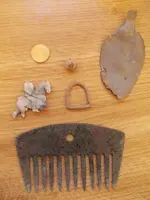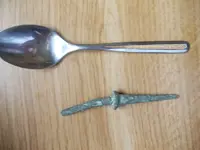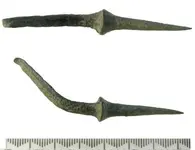Horst
Sr. Member
I went to a small village which had it's 850th anniversary some years ago hunting a pasture.
seems like it was very common that horsemen were "headless" these time as this is already my 2nd find missing it's head.

I am just not sure what this is....for size comparison I put a teaspoon next to it

the coin is a 10 Euro Cent coin but about 10 inches down...... pretty young for being that deep
seems like it was very common that horsemen were "headless" these time as this is already my 2nd find missing it's head.

I am just not sure what this is....for size comparison I put a teaspoon next to it

the coin is a 10 Euro Cent coin but about 10 inches down...... pretty young for being that deep
Upvote
25



 Its a neat find what ever it is!!!
Its a neat find what ever it is!!!

 .
.

